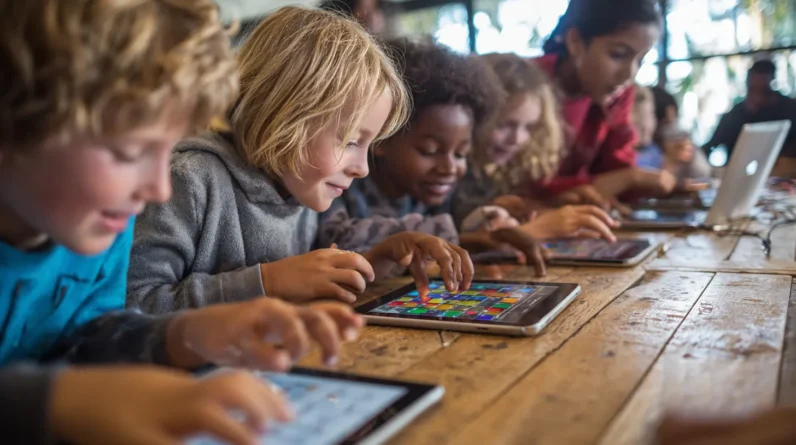
Smart devices greatly impact childhood development and learning, offering both benefits and risks. They can enhance problem-solving skills and accelerate knowledge acquisition through interactive apps and instant feedback. However, excessive screen time may hinder attention span, language development, and face-to-face interactions, potentially affecting empathy and emotional intelligence. While these devices can foster creativity and improve logical reasoning, they also pose physical health risks like eye strain and poor posture. We recommend a balanced approach, with intentional, age-appropriate use and clear parental boundaries. By understanding these impacts, we can harness the potential of smart devices while mitigating their drawbacks for ideal child development.
Cognitive Development and Learning
The impact of smart devices on children’s cognitive development and learning is a topic of increasing interest among researchers and educators. We’re seeing both positive and negative effects on children’s cognitive abilities. On one hand, interactive educational apps can enhance problem-solving skills, spatial reasoning, and memory. They provide instant feedback and personalized learning experiences, potentially accelerating knowledge acquisition.
However, excessive screen time may hinder attention span, language development, and social skills. We’ve observed that overuse of smart devices can lead to decreased face-to-face interactions, which are vital for developing empathy and emotional intelligence. Additionally, the constant stimulation from digital media might impair children’s ability to focus on tasks requiring sustained attention. It’s important to strike a balance, leveraging the benefits of smart devices while mitigating potential drawbacks through intentional, age-appropriate use and parental guidance.
Social Skills and Interactions
Shifting our focus from cognitive aspects, we’ll now explore how smart devices affect children’s social skills and interactions. Research indicates that excessive screen time can hinder the development of essential interpersonal abilities. Children who spend more time on smart devices often experience:
1. Reduced face-to-face communication
2. Difficulty interpreting non-verbal cues
3. Decreased empathy and emotional intelligence
These impacts can lead to challenges in forming and maintaining relationships. However, it is significant to highlight that smart devices can also facilitate social connections, especially for children with social anxiety or those living in remote areas. The key lies in balance and guided usage. By encouraging a mix of digital and in-person interactions, we can help children develop robust social skills while benefiting from technology. Parents and educators play a critical role in modeling healthy device use and fostering opportunities for real-world social engagement.
Creativity and Problem-Solving
As we explore the domain of creativity and problem-solving, we’re confronted with a complex interplay between smart devices and children’s imaginative capacities. Research indicates that while interactive apps can foster creative thinking, excessive screen time may hinder the development of vital problem-solving skills. We’ve observed that children who engage in open-ended play with physical objects often demonstrate superior spatial reasoning and divergent thinking compared to those primarily using digital interfaces. However, well-designed educational apps can enhance logical reasoning and pattern recognition.
It’s important to strike a balance, encouraging both digital and traditional forms of creative expression. We must also consider how smart devices can be leveraged to augment, rather than replace, hands-on learning experiences. By doing so, we can nurture children’s innate problem-solving abilities while embracing the benefits of technological advancements.
Physical Health Considerations
Physical health considerations frequently take center stage when discussing the impact of smart devices on childhood development. We must consider the potential effects on children’s bodies and overall well-being. Extended use of smart devices can lead to:
1. Musculoskeletal issues from poor posture
2. Eye strain and vision problems
3. Reduced physical activity and obesity risks
Research indicates that prolonged screen time may contribute to these health concerns. We’ve observed an increase in complaints of neck and back pain among young device users, often referred to as “text neck.” Additionally, the blue light emitted by screens can disrupt sleep patterns, potentially affecting growth and cognitive function. To mitigate these risks, we recommend implementing strict time limits on device usage and encouraging regular physical activity. It’s essential to balance the benefits of smart devices with the need to protect children’s physical health during critical developmental stages.
Parental Guidance and Boundaries
Parental guidance and establishing clear boundaries are essential components in managing children’s interactions with smart devices. We must recognize that our role as parents and caregivers is vital in shaping healthy digital habits. By setting clear rules and time limits, we can help children develop self-regulation skills and balance screen time with other activities. It’s important to model responsible device use ourselves and engage in open discussions about online safety and digital citizenship.
We should also prioritize co-viewing and co-playing, which allows us to guide children’s interactions and foster critical thinking skills. By implementing device-free zones and times, such as during meals or before bedtime, we can promote face-to-face interactions and protect family time. Consistent enforcement of these boundaries helps children understand the importance of responsible device use.
Conclusion
We’ve explored the double-edged sword of smart devices in child development. Like a digital sun, they can nurture growth or scorch young minds. Our research illuminates both benefits and risks to cognition, socialization, creativity, and health. We must cultivate a balanced approach, setting clear boundaries while harnessing technology’s potential. As guardians of the next generation, it’s our responsibility to guide children through this digital landscape, ensuring they reap the rewards while avoiding the pitfalls.







